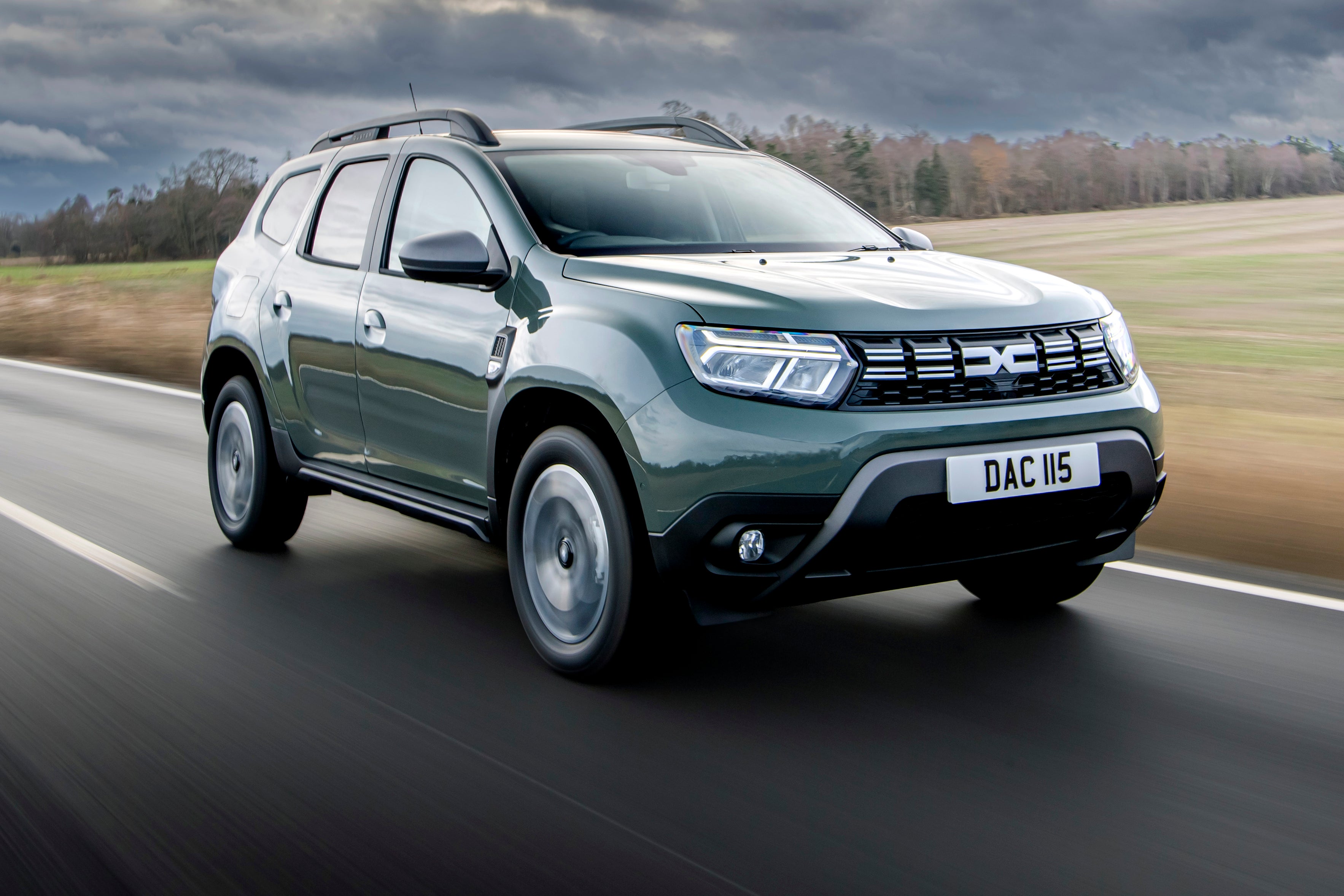Dacia Duster (2018-2024) Review
Written by Andrew Brady
Quick overview
Pros
- Very affordable small SUV
- More practical than a Focus-sized hatchback
- Some will love its no-nonsense approach
Cons
- The cheapest models are more basic than Duplo
- Less refined than mainstream alternatives
- Its three-star safety rating lets it down
Overall verdict on the Dacia Duster
"You can buy a brand new Dacia Duster for less than a Ford Fiesta, while nearly-new examples represent excellent value for money on the used market. The Duster is comfortable, practical and cheap to run, although it's clear where costs have been cut. Updates in 2021 mean it's slightly more desirable than before, while even entry-level models now come with a radio."
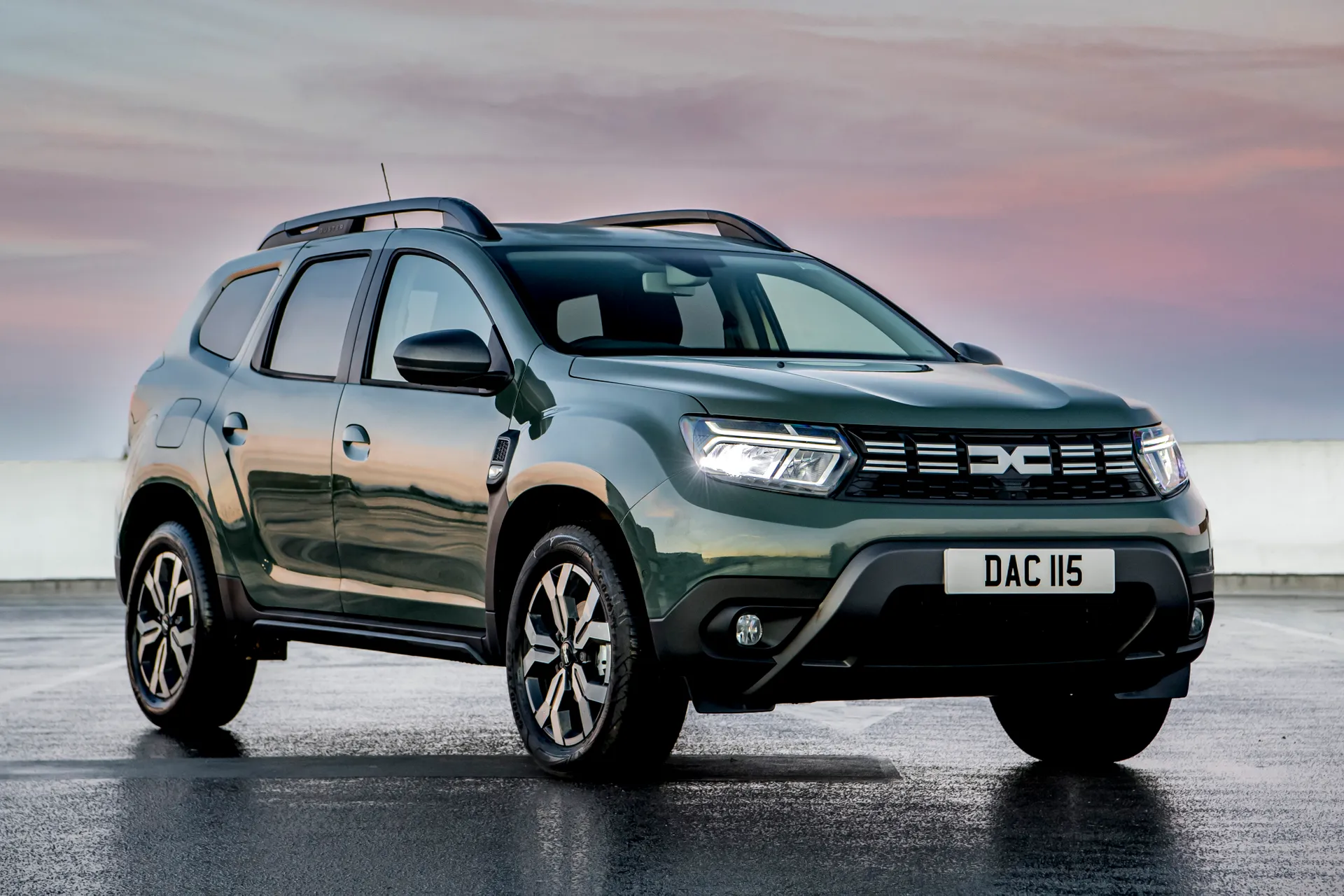
Just like budget brand food items at the supermarket, the Dacia Duster does almost exactly the same job as more expensive alternatives, but with less of the fuss. There’s no fancy packaging and it certainly won’t impress your neighbours, but the Duster is a versatile small SUV that offers plenty of space for not a lot of cash. It's also one of the best 4x4s if you're on a budget. We'll explain all in our 2024 Dacia Duster review.
You may not be familiar with Dacia Duster (how’ve you missed the TV ads?!), but the firm’s been selling cars in the UK for several years now. It’s Renault’s budget brand, meaning it shares many parts (including engines) with Renault models, while the Duster is based on the same platform as the previous-generation Captur.
Dacia Duster models are produced in Romania and sold in the UK through no-nonsense dealers that don’t negotiate on price. What you see is what you pay. You can save money by looking at the used market, though, where Dacias are significantly cheaper than mainstream alternatives.
That means you can pick up a much newer Duster rather than something like a Kia Sportage or Nissan Qashqai. It even looks cheap alongside smaller SUVs like the Suzuki Vitara and Nissan Juke. It’s a similar approach to that taken by the likes of the SsangYong Tivoli (now the KGM Tivoli since the company's rebranding) and MG ZS.
The Duster was updated in 2021 when it was given chunkier looks and the option of a new eight-inch infotainment screen. The interior also gets new upholstery and, on some models, a centre armrest with 1.1 litres of storage hidden underneath. Also new is the six-speed dual-clutch gearbox, which comes in combination with the front-wheel drive 150PS TCe petrol engine.
The Dacia Duster remains an ideal choice if you put practicality above things like brand image. There’s plenty of room inside, with a generous amount of headroom and space for three adults in the rear. The boot capacity of the Duster is 445 litres and bigger than you’d get in something like a Volkswagen Golf and access is easy.
While standard equipment is lacking on more affordable trim levels (at first, you didn’t even get a radio on the entry-level Access) of the Dacia Duster, mid-range models come with everything you need and nothing you don’t. High-spec and special edition models make little sense, really, as they cost more money yet still don’t feel as well-finished as mainstream alternatives.
To drive, the Dacia Duster continues its function-over-form approach. It’s refreshingly soft, with a wallowing suspension that lollops (rather than crashes) over bumps in the road. You can choose from petrol or diesel engines, and there’s even an LPG option. The 1.3-litre TCe 130 petrol is by far the best all-rounder, though, combining excellent refinement with low running costs.
The Dacia Duster’s biggest weakness is the three-star result it achieved when it was crash tested by Euro NCAP in 2017. Being a basic model, the Dacia Duster lacks many preventative safety systems we take for granted in new cars today, such as lane-assist and autonomous emergency braking features.
We would say you get what you pay for but, in reality, the Dacia Duster does better than that. It represents very good value for money, offering a huge amount of practicality and a not-unpleasant driving experience. It won’t suit everyone, but the Dacia Duster still holds plenty of appeal for the right kind of buyer.
Looking for a used car for sale? We've got 100s of Dacia Approved Used Cars for Sale for you to choose from, including a wide range of Dacia Duster models for sale. If you're looking for the newer version, you need our Dacia Duster review, while you might also be interested in our previous generation used Dacia Duster (2012-2015) review.
Is the Dacia Duster right for you?
If you’d ordinarily be looking at a value hatchback like a Vauxhall Astra but the versatility of a small SUV appeals, the Dacia Duster is a good choice. It’s considerably cheaper than mainstream rivals like the Kia Sportage and Nissan Qashqai - and that’s evident in so many areas. It lacks the polish of these alternatives and the most affordable models are about as basic as you can get in a modern car today.
Still, it’s got a functional interior with plenty of space. It should handle day-to-day abuse fairly well, and it’s refreshingly comfortable in its approach thanks to its soft, wallowy suspension.
What other cars are similar to the Dacia Duster?
If a Dacia Duster is on your small 4x4 shortlist, we’d also recommend the SsangYong Tivoli (now the KGM Tivoli since the company's rebranding). Like the Duster, this is another affordable small SUV that most car buyers won’t have heard of. Unlike the Duster, it comes with a five-year, 100,000-mile warranty, which can be passed onto successive owners.
You should also consider the MG ZS. While, if you don’t need the practicality, look at smaller, mainstream alternatives like the Suzuki Vitara, Renault Captur and Peugeot 2008 You could also get a slightly older Kia Sportage, Jeep Renegade or Nissan Qashqai for the money.
Comfort and design: Dacia Duster interior
"The Dacia Duster isn’t a car that’s been designed with flair or style in mind - and that’s most obvious in the cabin. It’s a functional cabin and not quite the mishmash of Renault parts that the previous model was, but it’s clear that costs have been saved here. "

Dacia Duster Access and Essential models are particularly spartan inside, although the upholstery that was brought in for the 2021 model year improved things and you also get slimmer rear headrests that give you a better view out the back.
As its name suggests, the Dacia Duster Comfort is a little more acceptable inside. While the steering wheel isn’t wrapped in leather, it is finished in a ‘soft-feel’ material, which is better than the rock-hard wheel of the standard car.
The Duster Comfort comes with a few bits of chrome, such as on the gear lever and steering wheel. This does little to distract from the dank cabin, but it’s welcome nonetheless. Prestige models go a step further with higher quality upholstery and climate control, but it still feels downmarket compared to a Renault Captur.
On the plus side, the seats are comfortable enough, although lumbar adjustment isn’t available on any Duster. The Dacia Duster Access doesn't even have a height-adjustable driver’s seat or steering wheel, so make sure you test out the driving position before you part with cash for one. It’ll suit some drivers, but certainly won’t fit everyone.
From an interior design perspective, everything is where you’d expect to find it, with simple controls for things like the heating system and air conditioning (on higher-spec models). Manual rear windows on the more affordable trim levels are a bit of a novelty - great for showing your kids what it was like in the olden days.
Quality and finish
Just like the Duster’s cabin is functional rather than stylish, it’s also not particularly posh. Dacia’s made little effort to furnish it with soft-touch materials, but that would kind of go against the brand’s budget ethos. There are hard, scratchy plastics everywhere - the likes of which would normally attract our wrath, but you’ve got to admire the brand’s no-nonsense approach.
On the plus side, the Dacia Duster does feel like it’ll stand up to day-to-day abuse very well. People buy this Romanian workhorse to take their families camping or for even more arduous activities such as use on the farm, and they take the abuse fairly well. The interiors can be wiped clean and don’t require special treatments to keep them looking fresh.
Infotainment: Touchscreen, USB, nav and stereo in the Dacia Duster
While we take flashy infotainment systems as the norm these days, entry-level Dacia Duster Essential models get a basic DAB stereo only (chin up, it wasn't that long ago you didn't get a stereo at all). You also get Bluetooth connectivity and controls on the steering column. There’s no navigation, though.
For that, you’ll need to look for a Dacia Duster Comfort, which comes with a new-for-2021 eight-inch infotainment system, which replaces the seven-inch screen in older versions. This comes with Apple CarPlay and Android Auto, allowing you to mirror apps from your phone, meaning you can use things like Google Maps on the move. If you're after built-in sat-nav, you'll need the top-spec Dacia Duster Prestige.
The eight-inch system isn’t the slickest we’ve ever used. The graphics make it look pretty low-rent, while it’s a bit slow to respond. It’s kind of like a budget tablet you can buy from the supermarket. It’ll do the job, but no one’s going to mistake it for an iPad.
Space and practicality: Dacia Duster boot space
For the cash, the Dacia Duster is massively practical. It might be cheaper than small SUVs like the Suzuki Vitara, yet it’s almost as spacious as cars like the Kia Sportage and Skoda Karoq. The Dacia Duster measures just over 4.3m long and a little over 1.8m wide.
Thanks to its high ride height and seating position, getting in and out of the Duster is easier than with low-down hatchbacks. This is great if you’re reaching the age when your joints aren’t quite as flexible as they used to be, or if you have kids in car seats that need helping into position.
There’s plenty of room in the front although, as mentioned above, there’s limited adjustment in the driver’s seat and steering wheel on the cheapest models. The tallest of drivers might find legroom limited, too, as the seats don’t slide back as far as rivals.
While the cup holder is poorly positioned to prevent spillages (in front of the gear stick), there’s enough storage dotted around the cabin. The door pockets are pretty big, but the glove box is a pretty meagre offering.
Three adults can squeeze into the back in reasonable comfort, providing they don’t mind rubbing shoulders. There’s a reasonable amount of headroom back there, while ISOFIX points on the outer seats help when fitting child seats.
The Dacia Duster's boot is similarly practical, offering 445 litres of luggage capacity (dropping to 411 litres in 4x4 models). It lacks any real party tricks, although the rear seats drop easily. The rear seats in most models split 60:40 (allowing you to carry one or two rear passengers and have extra boot space), but the entry-level Access model makes do with a one-piece bench. With the rear seats dropped, there’s up to 1623 litres of space available. That’s pretty generous.
Access is easy enough, although you’ll obviously have to lift items higher than you would with a conventional hatchback car. There’s only a small lip to hoist items over, and the boot is usefully square in shape.
The Dacia Duster doesn’t come with a spare wheel as standard, although a space-saver is offered across most models as an optional extra when new. A Dacia dealer should be able to sell you one of these if required, and there’s space to store it under the boot floor. That’s not the case of bi-fuel models, though, as there’s an LPG tank in the spare wheel storage well. These come with a tyre-inflator kit.
Handling and ride quality: What is the Dacia Duster like to drive?
"Pricier SUVs like the Skoda Karoq and Nissan Qashqai have more sophisticated suspension setups, but we quite like the Dacia Duster’s old-school approach. That means it’ll bounce over bumps in the road and lean like a cumbersome old Land Rover through the bends."
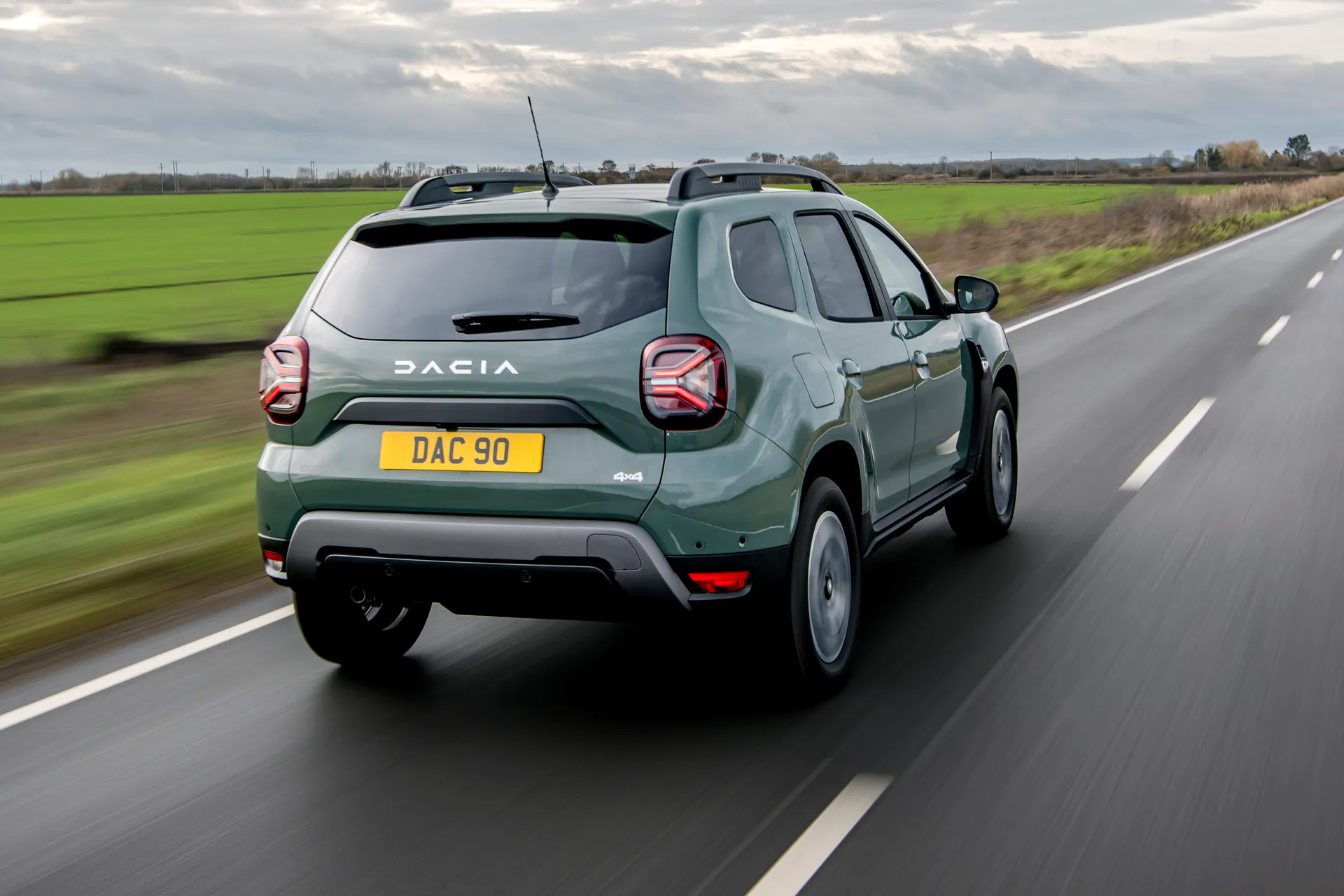
The spongey suspension and small wheels (with large tyres) means the Dacia Duster's quite a comfortable car and a pleasant alternative to all the sportier small SUVs on the market. It’s not quite a magic carpet ride in the same ilk as the Citroen C5 Aircross, but it’s certainly acceptable on all but the bumpiest of roads. A downside of the soft setup is, on a windy motorway, you will feel it being blown about a little more than most modern alternatives.
And, of course, it’s not going to be as quick down a winding road as a SEAT Ateca. The unwieldy steering of the Dacia Duster adds to the old-school approach, and although it was recalibrated in 2021 to add more feel at speeds above 43mph, it's still not as direct as in rivals such as the SEAT.
That means you’ll have an idea of how much grip there is on offer which, all too often, isn’t very much. That said, four-wheel-drive versions of the Dacia Duster are excellent off-road, able to tackle muddy fields with ease. You’ll want a bit more ground clearance if you’re planning on following a Land Rover Defender down a rutted track, but it’s surprisingly capable for a cheap SUV.
The Dacia Duster's good around town, too, its low-geared steering is very light, and the high seating position and reversing camera on all but the most basic models makes it easy to tackle congested roads and tight car parks.
If that's the kind of driving you do, the 150PS model with the EDC gearbox is worth considering. The dual-clutch gearbox offers crisp changes and a welcome relief from operating a clutch pedal – enough to make up for slightly jerky low-speed manoeuvring.
Plan to use your Duster for farm yard duties? Then you'll need the 115PS diesel – the only model that's available with four-wheel drive. Check that option and your Duster comes fitted with all-weather tyres fitted as standard and has an infotainment display with an altimeter, plus inclinometer, pitch and compass readouts.
What engines and gearboxes are available in the Dacia Duster?
If you’re searching for a used Dacia Duster on a budget, you’re probably going to see the entry-level TCe 100 petrol engine coming up in results. Even the most leisurely of drivers will find this lacking - indeed, its lack of gusto means you’ll end up working it hard just to keep up with traffic, and good luck trying to join on a motorway on a short slip road. This engine replaced the naturally aspirated 1.6 - badged the SCe 115 - that was offered when the Duster first went on sale, and that engine suffered similar drawbacks.
From early 2020, Dacia offered the TCe 100 engine with a bi-fuel option, while a 62-litre Liquid Petroleum Gas (LPG) tank (double the size of old tank) was fitted from 2021, extending the LPG range by more than 155 miles for a massive 767-mile total range running on both gas and petrol. It makes a lot of sense if you have a handy LPG station nearby.
Most buyers will be best looking for a TCe 130 petrol engine with the Dacia Duster. This is the best combination of frugality and performance, with plenty of oomph for motorway driving. Its 10.6-second 0-62mph time sounds less than brisk, but it’s perfectly acceptable for a budget small SUV.
The 150PS version of the same 1.3-litre four-cylinder petrol engine is the nippiest of the lot – getting the Duster from 0-62mph in 9.7 seconds and onto a healthy 124mph top speed. That said, the most compelling reason to choose it is the six-speed dual-clutch gearbox that it comes with as standard.
If you spend a lot of time traipsing up and down motorways or need to lug a caravan, look for a diesel. With 115PS, the 1.5-litre Blue DCi isn’t particularly powerful, but it feels punchier than the petrols in the real world.
While most Dacia Duster models are two-wheel drive, you can also get it with power distributed to all four wheels. Four-wheel-drive Dusters are difficult to come by on the used market but that’s no great loss - they’re thirsty and don’t offer many advantages unless you really need to venture off the road. If you’re concerned about driving in wintery conditions, a two-wheel-drive Duster with a set of winter tyres would be a better option.
Refinement and noise levels
Thicker glass, extra sound insulation and thicker door seals mean the latest Dacia Duster is more refined than the previous model, but it’s still not up to the standards of cars like the Skoda Karoq.
The diesel engine makes quite a grumble at idle but, fortunately, stop/start is standard - turning the engine off automatically at a standstill. On the move, there’s a surprising amount of vibration through the pedals and gearstick. This is another area in which the Duster feels rather old-school.
The petrol engines are better with the Dacia Duster. Being a small three-cylinder unit, the entry-level TCe 100 is quite vocal, and that’s not helped by only having five gears. On the motorway, the engine will be screaming away at high revs, which isn’t great for fuel economy or your passengers’ relaxation levels.
The quietest engine is the 1.3-litre TCe - either with 130PS or 150PS. You’ll notice a bit of chatter if you work it hard, but it’s no less refined than the small, turbocharged engines used in rivals.
Chunky tyres mean there isn’t much in the way of road noise, but there is a significant amount of wind noise, especially at speed. It means that, whichever engine you choose, the Duster isn’t a particularly relaxing long-distance companion.
Safety equipment: How safe is the Dacia Duster?
The majority of new cars on sale today achieve maximum five-star safety ratings from Euro NCAP. The Dacia Duster was awarded just three when it was crash-tested in 2017 which, on the face of it, is pretty poor.
It’s worth taking a little time to understand the results before you dismiss the Duster entirely, though. Euro NCAP awarded it a 71 per cent rating for adult occupants, which is acceptable (if not class-leading). It lost points for what NCAP described as ‘marginal protection against whiplash’ and various other faults which, admittedly, you probably wouldn’t see as minor if you were in a crash.
It was awarded 66 per cent in the child occupancy test. Parents would be right to dismiss the Duster on this basis, but don’t expect an old, more mainstream alternative to be any safer. NCAP’s report suggests that protection of the child-size dummies was classed as good in most of the tests. It lost points for not having ISOFIX points on the front passenger seat, while those in the rear aren’t clearly marked. They are there, however.
The Duster lost the most points for its safety assist features, or rather, the shortage of them. While most mainstream SUVs are packed with standard features designed to prevent you from having a crash, Dacia’s skimped on these. Highlights include a seatbelt reminder and a driver-set speed limiter. There’s no autonomous emergency braking system, no lane guidance feature and no rear cross-traffic assist. Only high-spec models get a blind-spot warning system.
While these features are desirable and could prevent you from being involved in a collision, the Dacia Duster’s no worse than many slightly older small SUVs.
MPG and fuel costs: What does a Dacia Duster cost to run?
"Just as the Dacia Duster is cheap to buy, it should be cheap to run, too. If you’re after outright fuel economy, look for a two-wheel-drive model with the 115PS dCi diesel engine. Officially this’ll return up to 57.9mpg under WLTP tests (depending on spec). Real MPG data from Honest John suggests you won’t be far from achieving this in the real world - mid-50s should be realistic if you’re gentle with the throttle."
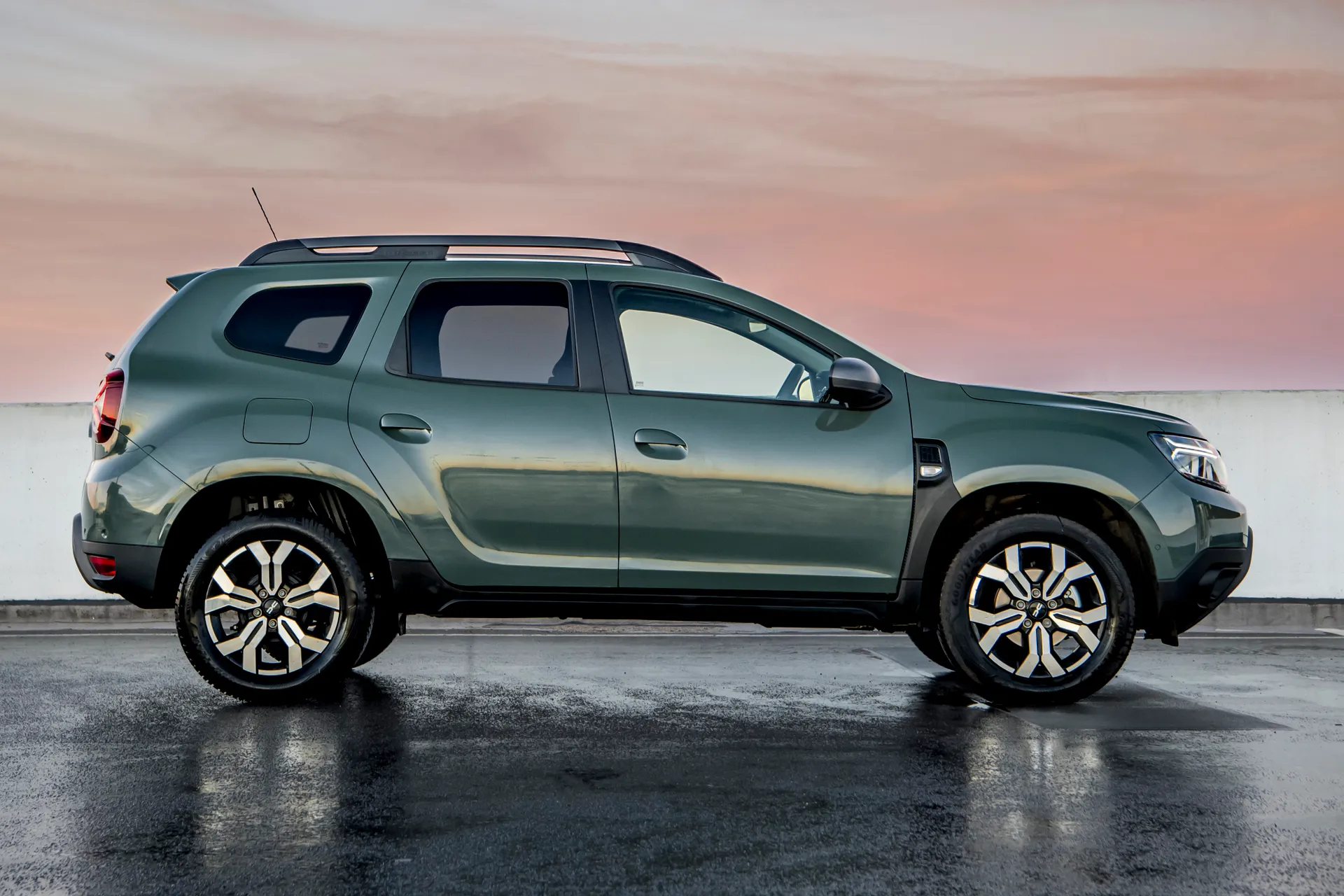
Four-wheel-drive Dacia Duster models are slightly thirstier, returning around 50mpg - although this is still pretty good for a capable little 4x4.
If you don’t cover many miles and don’t need the torque of a diesel engine (i.e. for tackling steep hills, off-roading or towing), we’d recommend a petrol Dacia Duster. All of the petrols can achieve mid-40s mpg, unless you’re running one of the bi-fuel models on LPG - in which case, expect mid-30s. The cheaper cost of LPG should negate this, but you might struggle to find a convenient refuelling station.
How reliable is the Dacia Duster?
Dacia may be a relatively new brand in the UK - and a budget one too - but that doesn't mean it's not reliable. Indeed, the brand performed very well in the latest HonestJohn.co.uk Satisfaction Index, making the list of the top 10 most reliable brands in the study, finishing 5th overall. Interestingly, it was also the only brand in the top 10 that wasn't Japanese or Korean.
What's more, the Duster was Dacia's most reliable performer in the study, with the model making the top 10 of the most reliable cars, finishing 8th overall. All of this should give you plenty of confidence about the car's ongoing reliability.
Insurance groups and costs
Most versions of the Dacia Duster ought to be pretty cheap to insure, with insurance grouping starting at 9 (out of 50) for the SCe 115 car in the most basic trims. They rise to a heady 24 for the most powerful petrol autimatic version in the poshest trim, but that's something of an outlier. Most engine/trim combinations sit aorund ot below the group 15 mark.
VED car tax: What is the annual road tax on a Dacia Duster?
Under the latest car tax rules, petrol and diesel Dacia Duster models attract the flat rate of £180 a year (after year one) for car tax. Bi-fuel versions, which use a combination of LPG and petrol, are classed as alternatively-fuelled, so attract an annual VED rate of £170. Yup, you’ll save a tenner a year. Year one road tax is reasonable across the line-up.
How much should you be paying for a used Dacia Duster?
"The Dacia Duster is a budget car when new, and you’ll be pleased to know that this is passed down onto the used market."
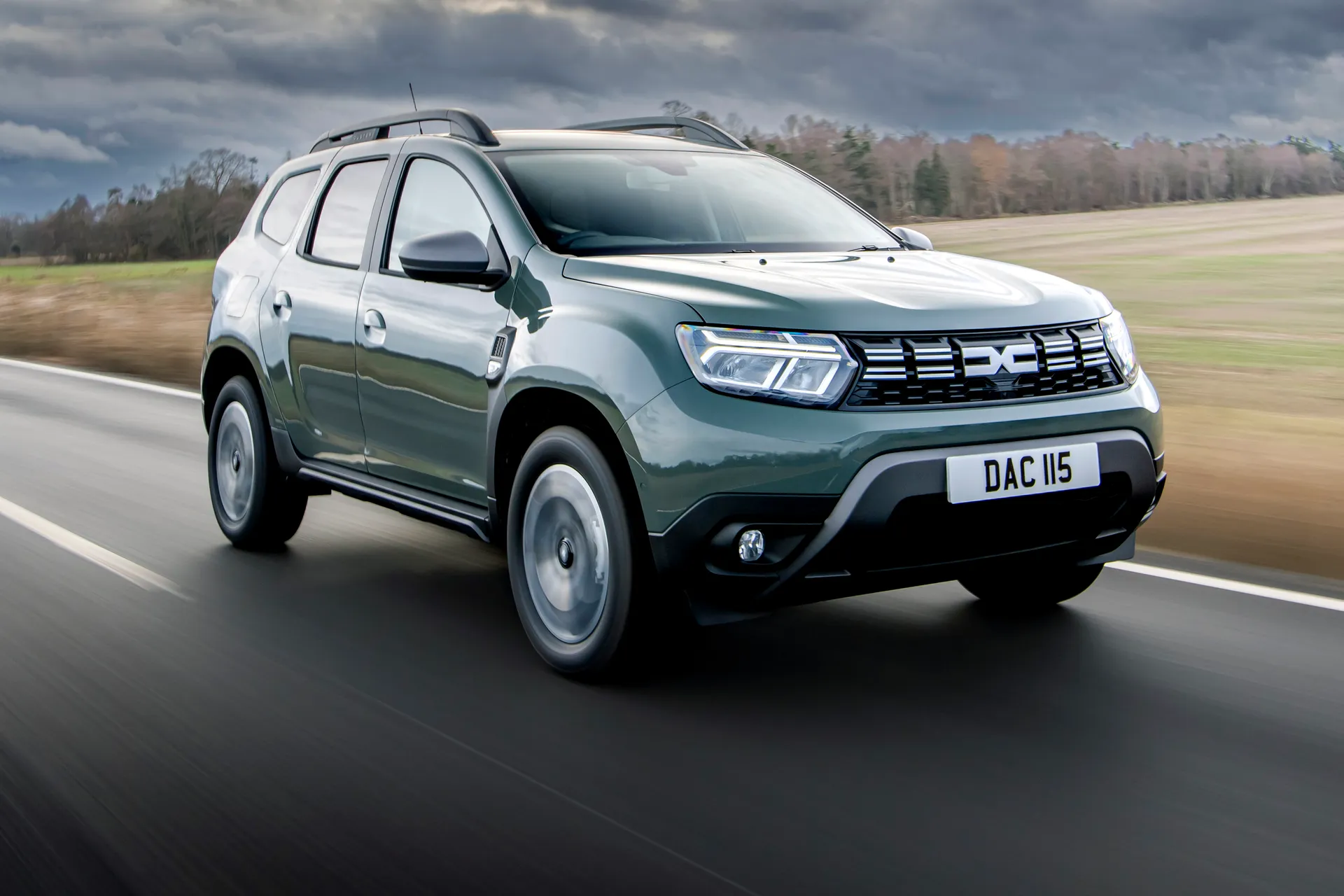
The Duster isn't quite as dirt cheap as it once was - what is these days? - but it's still a very affordable car by modern standards. On the new car market, prices range from around £17,000 up to around £24,000.
And because it's been around for a fair old while since 2018, there are lots of examples on the used market whose value has had time to fall further. The cheapest Mk2 Dusters in our listings can be had for around £9,000. These are fairly entry-level versions, but they're no carrying silly mileages - around 40,000 in most cases. That really is cracking value. The cheapest cars are mostly petrols, but there are some diesels available for similar cash, too.
Trim levels and standard equipment
For most of the Dacia Duster's life, three trim levels were offered – Essential, Comfort and Prestige. The basic-level Access trim level was dropped fairly early on in the car's life, and it was one of the most basic cars on sale, which is probably why it's no longer with us in the UK. It didn’t even come with a radio. It did, however, come with pre-wiring for a radio and speakers so it’s fair to assume that, on the used market, most Access models will have had some sort of radio fitted.
It does have electric front windows (the rear windows are old-school wind-up affairs) along with 16-inch steel wheels and, erm, that’s about it. We told you it was basic.
Unless you really want to torture yourself, we’d suggest looking for a Dacia Duster Essential at the very least. This adds such luxuries as body-coloured bumpers, manual air conditioning, a height-adjustable driver’s seat and steering wheel, and a DAB radio with Bluetooth connectivity.
The Dacia Duster Comfort builds on this with cruise control, 16-inch alloy wheels (replacing steel items of the same size), electric windows and a seven-inch touchscreen navigation system with Apple CarPlay and Android Auto. There’s a rear-view camera with parking sensors and the passenger even gets a little vanity mirror in their sun-visor.
Topping the range is the Dacia Duster Prestige, with 17-inch alloy wheels, climate control, keyless entry, heated and electrically-adjustable door mirrors and posher upholstery.
There have been a few special editions, too. The Techroad edition of 2019 sat above the Prestige trim, available in two new colours (Fusion Red and Highland Grey) with some bespoke side decals and red exterior (and interior) detailing. The 2020 SE Twenty featured blue interior and exterior styling highlights, as well as a multi-view camera and blind-spot detectors.
Towards the end of the Mk2 Duster's life, the trim structure was changed to include Essential, Expression, Journey and Extreme trims. At this point, equipment levels became far more generous. Essential came with 16-inch steel wheels, LED daytime running lights, automatic headlights, front fog lights, rear parking sensors, and black roof bars, while inside there’s a height and reach-adjustable steering column, cruise control with speed limiter, seven-function on-board computer, DAB Radio and manual air conditioning.
Expression added alloy wheels, heated and electrically adjustable door mirrors, body-coloured door handles, and Hill Descent Control, height-adjustable driver’s seat with lumbar adjustment, leather steering wheel, electric rear windows, rear-view camera, and an eight-inch Media Display infotainment system complete with Android Auto and Apple CarPlay. Journey trim tops that up with dark-tinted rear windows, automatic wipers, automatic air conditioning, keyless entry, electric folding door mirrors, Multiview camera, front parking sensors, blind spot warning system, heated seats, and an eight-inch Media Nav on-board navigation system. Extreme models get their own look thanks to a bunch of styling enhancements, but you don't really get anything more in the way of luxury kit.
Ask the heycar experts: common questions
Who makes Dacia engines?
Who makes the Dacia Duster?
Are Dacia Dusters reliable?
Get our latest advice, news and offers
Keep me updated by email with the latest advice, news and offers from heycar.
By submitting you agree to our privacy policy
